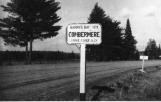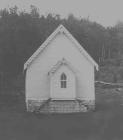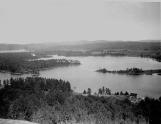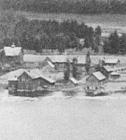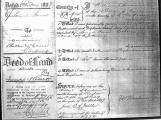1
Combermere was named in honour of Sir Stapleton Cotton, Viscount Combermere (1773-1865) who commanded cavalry in the Peninsula War. He was Commander-in-Chief in India (1825-1830) and was Field Marshall in 1855. His seat was Combermere Abbey in Cheshire, England.Combermere was called Dennison’s Bridge before the Post Office was established in 1865. The term Dennison’s Bridge came from Captain John Dennison, one of the first pioneer settlers in this area. Captain John served under Sir Stapleton Cotton before coming to Dennison’s Bridge and hence the new name Combermere.
3
Radcliffe Township received it’s name in 1859 from the Hon. Thomas Radcliffe who fought under the Duke of Wellington and then settled in Wellington County and became a member of parliament.On October 5, 1860, the Townships of Brudenell, Radcliffe, Raglan and Lyndock were incorporated as a joint municipality, within the United Counties of Lanark and Renfrew. Brudenell was named the senior township of the municipality.
In 1902, Radcliffe became a separate township and held it’s first council meeting on January 13, 1902. The following were the First Officers.
Reeve - (Captain) John C. Hudson
Councillors James H. McKay
Thomas Mahon
Joseph Mayhew
William Boehme
Treasurer W. E. James
Clerk John E. H. Miller
Combermere, being the hub of the Township became a hamlet of importance and today is an important community for various reasons. Radcliffe, like most areas in this county was settled mostly by farmers who came and located in various parts of the township, those of Polish ancestry around Halfway - a stopping place halfway between Craigmont and Barry’s Bay - and therefore the name. Some settled on the Opeongo Line at Hopefield and then again more settled on the Hastings - Opeongo Junction Road near Rockingham.
The people of German ancestry (Wendish) settled in the south eastern section around Rosenthal while the French settled on the Combermere - Carlow road, a few miles from Combermere towards the south west.
Since then, there have been many changes in the Township of Radcliffe - new homes, schools and businesses along with several tourist establishments.
The township offices for Radcliffe in 1914 were in the old Methodist church before it was demolished in the late 1950's.
A new municipal building was built in 1962 with the addition of a fire hall in 1971 when a fire truck was purchased and a fire-fighter’s group organized.
The latest addition to the township buildings is the new recreational hall which is now on the same area and there is an outdoor rink that has been in operation for several years.
Very few of the old buildings of former years remain. There are a few and hopefully these shall be in good repair as a memento of yesteryear. A new separate school replacing one which was burned, a new Roman Catholic Church after the fire destroyed the old one in 1951, a post-office, stores, garages, municipal office, fire hall, recreation hall, saw mill, public school, trailer camps, tourist lodges, a motel and restaurant, and ski chalet serving a ski hill and former golf course.
In the year 2001, with pressure form the Ontario government, an amalgamation took place rolling Radcliffe township into a larger Madawaska Valley Township along with Sherwood, Johns & Burns (Barry’s Bay) and Hagarty (Wilno). The municipal office in Combermere was closed at that time and the Barry’s Bay municipal office now handles all of the greater township functions.
5
Combermere, a scattered community of about 250 population, lies where highway 62 crosses approximately the middle of a 38 mile stretch of navigable waterway on the Madawaska River, 925 foot elevation.It has served the lumber industry in by-gone years under the name Dennison’s Bridge, when the square timber rafts were floated down from Algonquin Park to their destination in Ottawa, Quebec and across the seas to England. There are still signs of the old log drivers chutes where the timber was floated around the rapids on Byers Creek. For that time it was a busy settlement with several general stores, a tannery, woollen mill, grist mill, butter and cheese factory, sulky race track, blacksmith shop, shingle making, sawmills, shoe shop and two hotels which served the river drivers.
7
John Dennison emigrated from England to Montreal in 1825. He took part in the Rebellion of 1837-38, earning himself the title of Captain. From Montreal, he traveled up the Ottawa River, accompanied by his two sons John and Henry. They then ascended the Madawaska River for many miles landing at a spot which came to be known as Dennison’s Bridge. In 1854, Captain Dennison and his son Henry, traveled further to Opeongo Lake and settled there. Elizabeth Dennison married John Hudson who had come out from England and in 1878 they took over the stopping place, later known as the Hudson House (but built originally as Dennison House). John Dennison moved across the river and built the log house which stood, although long since deserted, until it fell in one stormy night Feb 11th, 1951.Other settlers soon arrived. Mr. Dan Johnson came from Ontario to open Combermere’s first store. The second store was owned by Henry James but it burned in the August 5th, 1911 fire. It was later rebuilt by Frank Stafford and then ultimately owned by Mr. William Waddington who arrived from Leeds, England, to open a third store and to grind flour on large flat stones. McLaughlin Brothers of Arnprior saw the great wealth of timber in this country, and began lumbering operations with a depot at the foot of Kamaniskeg Lake (now Chippawa Cottage Resort) and Palmer Rapids, which is still known as McLaughlin’s Farm. These two brothers, Messrs Claude and H.F. McLaughlin became millionaires through the forest wealth of our country. With time, they brought work for men, who began pouring into the community.
In 1871, a small log schoolhouse was built on land purchased from Mr. Dennison for one dollar. The first teacher was the doctor’s wife and she received one hundred and fifty dollars a year. The school was used for church services and the doctor did the preaching. Today, there is a catholic elementary school.
Many were the hardships endured by the early settlers. Mr. John Dennison walked, many a time to Eganville, fifty-one miles and carried home a bag of flour on his shoulder. When he accidentally shot off his thumb, he had to walk to Ottawa some hundred and thirty miles, for medical attention. The mail, eighty years ago, was brought by horses, from Cobden, fifty-five miles away, once a month. But times have changed through the years. We have excellent highways, a beautiful new bridge, and bus service to Pembroke and Toronto. Children are bussed to Public and High Schools and we have daily mail, and a splendid new Post Office.
8
But let us go back again to the early years. In 1865, the name of the village was changed to Combermere. No written record has been found, as to where the name actually came from. Some say it is named from a place in England (Combermere Abbey), and some say that the son of Lord Combermere once visited this place. Shortly after this, more settlers arrived, the Schwiegs and Boehmes from Germany, and the Farmers from Wales. This latter family opened a small shop, where they made river drive boots. The Reids opened a woollen mill, which has long since been torn down; Mr. James McKay, a gristmill, also gone. Mr. James built a store and home by the bridge, burned in the fire in 1911. Mr. Paddy O’Brien arrived from Rockingham and opened a hotel, known as O’Brien House.Should our pioneer grandfathers arise, what a change they would see, compared with the solitary pine-clad hills, that nestled down close to the river’s edge. Only the river itself, is forever the same.
Disaster struck Combermere, on August 5th, 1911. Fire broke out in the Hudson Hotel, and before it had burned itself out, had destroyed the store and dwelling of Mr. W. R. James, the Township Hall, Mr. C. B. Dennison’s home, hotel stables and S. James’ tinsmith shop. The hotel was rebuilt as a three-story brick building. Again fire struck in 1913, and the hotel was again destroyed. It was rebuilt the next year as a two-story structure and later contained Mr. Lew Waddington’s store.
But the greatest tragedy of all struck the village in 1912. Captain John H. Hudson ran a passenger and cargo boat between Combermere and Barry’s Bay. He had finished his summer’s run, when William 'Tailer' Boehme asked him to make a special trip - for a body (a relative of Mr.Boehme’s). Captain Hudson made the trip on the afternoon of November 12th, but he never returned. He had picked up a few passengers, who were glad of the opportunity of getting down to Combermere. A terrific storm overtook the ship and she went down in the wild waters of the Kamaniskeg. Four men clung to the coffin, and drifted to an island. One died of exposure, but the three were later rescued. Saved were Joseph Harper, Gordon Peverly and J. S. Imlach all of Ottawa. Died on the island was Paddy O’Brien. Those who went down with the ship were the following: Captain Hudson, Tom Delany, fireman, Aaron Parcher, pilot, all of Combermere, Robert Pachal of Yorkton, Saskatchewan who was accompanying the body of John Brown, of Palmer Rapids, who had accidentally shot himself out West. Also drowned were Mr. William Murphy of Rockingham and an eighty-year old lady, Mrs. Elizabeth McWhirter of Fort Stewart. It was the greatest tragedy that ever struck Combermere.
Combermere is a pretty little village, spreading along both sides of the Madawaska River. It contains two churches, the Roman Catholic and the Anglican. There are numerous stores, garages, a restaurant and a small hotel. Beside the river stands a new and beautiful building. It is the Convent of the Faithful Companions of Jesus. Beside the river, but nearer the village, is Madonna House, the training center and headquarters for the men and women, who dedicate their lives to work for God and the needy fellow-men. This institute began with a six-roomed lending library, and additional building for many activities. The members number is seventy persons. St. Benedict farm at Craigmont, part of the establishment, provides most of the food for the workers.
The beauties of Combermere, and the good fishing became known to the outside world; tourists flocked in and the fishing camps and tourist lodges sprang up. Among the early ones were Mrs. Maggie Hudson (widow of Captain Hudson, lost on the Mayflower), Fred Conley’s and Mrs. Boehme’s. Through the years the tourist trade has grown, and many lodges cater to the summer population. In 1934 the Women’s Institute was organized with a membership of 18 and it has kept up a membership slightly above ever since. The first president was Mrs. Sadler, the wife of Doctor Sadler, who practiced medicine here for many years. He was a familiar figure in the old days, at all hours, traveling the backwoods roads with his horse and buggy.
One of Combermere’s sons was Dr. John Dafoe, born on a farm not far from the village in 1886. He taught school in Combermere when very young. Then he attended Arnprior High School, walking to and from Arnprior, a distance of ninety miles each term. He went in for journalism, and became Editor-in-Chief of the Winnipeg Free Press, Montreal Star and became Chancellor of McGill University. He attended Press Conference in Britain and Australia and was a member of the Paris Peace Conference in Paris in 1919. He also published many books. His was the idea of the 'Commonwealth of Nations'. He was offered a cabinet post by Hon. MacKenzie King, but refused. He said he wanted no part in politics. This was because he had taken a responsible position, the year before. In 1934, Chancellor of the University of Manitoba, a position he held until his death in 1944.
Ours is a beautiful village, and there is no more wonderful sight than the autumn trees, reflected in the peaceful waters of the river. Artists have found it, and it is becoming a 'Painter’s Paradise'
On October 5th 1860, the townships of Brudenell, Radcliffe, Raglan and Lyndoch were incorporated as a joint municipality within the United Counties of Lanark and Renfrew. Brudenell was named the senior township of this municipality. In 1902 Radcliffe became a separate township and held its first council meeting on January 13th. The following were the officers: Reeve - John C. Hudson (Captain); Councilors - William Boehme; James H. McKay; Thomas Mahon; Joseph Mayhew; Treasurer - W. E. James; Clerk - J. E. H. Miller.
Radcliffe Township received is name in 1859 from Hon. Thomas Radcliffe who fought under the Duke of Wellington, in the Napoleonic Wars. Mr. Radcliffe was given a tract of land in Canada, and settled in Wellington County and became a member of Parliament.
10
James & Elizabeth Reid arrived in Combermere from Admaston Twp., Ferguslea, ON. His father Ephraim, was a descendant of Scottish weavers and emigrated to Ferguslea and started a woollen mill there. James and Elizabeth went up the Madawaska River and picked a location in Combermere to establish their own mill. It was near Miller’s Post office and St. Paul’s Anglican Church where the fire station is now located. James was born in Paisley, Scotland in 1845. Elizabeth was born July 1850 in Admaston Twp. The Reid’s had 8 children - Jane, Marion, Elizabeth, Phoebe, Lorne Ephraim, John F., Ross and Louis.They constructed a mill for the processing of the local farmers wool. James died before April 1891, leaving Elizabeth and their children to carry on the business.
By the turn of the century, Elizabeth decided to move the business to Bancroft where railway access was close by. The business was outfitted with the machinery from Combermere.
Lorne Reid, son of Elizabeth, operated the Bancroft mill which was located beside another woollen mill operated by David Fuller. Around 1905, a fire took out the gristmill, flour mills, power station and two woollen mills along the York River. The fire changed the course of their lives. Elizabeth moved to Toronto and Lorne built a new General Store in partnership with Frank Thompson on Bridge Street in Bancroft.
Elizabeth died in 1914 and her body was interred beside James in Ferguslea.
11
In the late 1800’s and early 1900’s, Combermere had a thriving grist mill for grinding farmers grain into flour. Farmers came to this facility from a wide area to have this work done. Before that, farmers in the mid 1800’s would have to travel to Eganville to have the work done. Rockingham also had a gristmill on the Rockingham Creek in the mid to late 1800’s and was owned and operated by William Watson, founder of the village.The Combermere gristmill was located on what is known today as Farmers Road and operated by the Cone family.
13
On May 5, 1897, The Combermere Cheese and Butter Company received a deed from Samuel Farmer who was given the land in 1895 as a free grant from the Crown. It would appear from the document that Samuel & Catherine Farmer along with N. E. James were partners and/or owners of the Company. William Boehme was the witness to the signatures and John E. H. Miller was the Commissioner for taking affidavits. The local farmers brought their milk to the factory and shared in the profits of the business when the butter and cheese products were sold.Edward & Catherine (de Hueck) Doherty of New York came to dwell on this same land in May 1947 and their first building (where the remains of cheese and butter company was located) became known as Madonna House.
This cheese factory was one of two known to exist in the area in the late 1890’s and into the early 1900’s.
The other factory was located on Centreview Rd. in the valley just past Whitley Rd. on the right side of the road in the bush. It was known as the Bangor Butter & Cheese Company. It is believed to have started in 1896 and lasted until 1907.
In 1897, the value of the cheese sold was $2324.28 and by 1902 it had risen to $4,017.35. In 1907, the officers of the Company were: George Hoare - President and Salesman, Secretary, Treasurer and George D. Oram - Cheesemaker. Directors were John Boyle, Joseph Long, Robert McMahon, Andrew James, Enoch James and Peter Dupuis. There were many other farmers and settlers who owned shares in 1906/07.
The factory building was quite the building. It was 30’ wide and 40’ long. It was comprised of board and batten siding on stone piers with floor beams 12" x 12" pine framed in timber. It had a platform at the front where milk was unloaded and had a tank close to the door for emptying the milk into. There were 2 vats - one on each side 6-8 feet across and 18-20 feet long. The roof had quite a steep pitch to it. At the corner there was a boiler 12’ long and was fired with 4’ wood. The boiler remained after the building was torn down until scrap dealers took it away. The boiler was used for heating water for the factory and water was pumped from the local creek by injector pressure. Steam was used to make milk into cheese. A separate icehouse at the back behind the building was 20’x 26’. The factory had a cheese press that many described as 'quite the machine'. Cans of milk came in twice a day, put on a scale, weighed and stamped with the owners name. The butter and cheese was sold in Combermere, Craigmont and to local settlers in Bangor. Ice came from White Duck Lake and James Lake. The factory was not operational in the winter as there was no insulation in the walls and ceiling of the building.
There was a distinct decline in milk coming into the factory and the product being sold in the 1907 and 1908 period. The most feasible reason for both factories decline was due to the lack of enough milk to operate at a profit, and the lack of places to sell the cheese.
